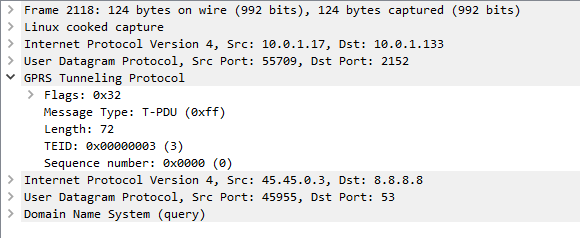Let’s take a look at GTP, the workhorse of mobile user plane packet data.
This post covers all generations of mobile data (2.5 -> 5G), so I’m using generic terms.
GSM, UMTS, LTE & NR all have one protocol in common – GTP – The GPRS Tunneling Protocol.
So why do every generation of mobile data networks from GSM/GPRS in 2000, to 5G NR Standalone in 2020, rely on this one protocol for transporting user data?
So Why GTP?
GTP – the GPRS Tunnelling Protocol, is what encapsulates and tunnels IP packets from the internet / packet data network, to and from the User.
So why encapsulate the packets? What if the Base Station had access to the internet and routed the traffic to the users?
Let’s say we did that, we’d have to have large pools of IP addresses available at each Base Station and when a user connected they’d be assigned an IP Address and traffic for these users would be routed to the Base Station which would forward it onto the user.
This would work well until a user moves from one Base Station to another, when they’d have to get a new IP Address allocated.
TCP/IP was never designed to be mobile, an IP address only exists in a single location.
Breaking out traffic directly from a base station would have other issues, such as no easy way to enforce QoS or traffic policies, meter usage, etc.
How to fix IP’s lack of mobility? GTP.
GTP addressed the mobility issue by having a single fixed point the IP Address is assigned to (In GSM/GRPS/UMTS this is the Gateway GPRS Support Node, in LTE this is the P-GW and in 5G-SA this is the UPF), which encapsulates IP traffic to/from a mobile user into GTP Packet.
You can think of GTP like GRE or any of the other common encapsulation protocols, wrapping up the IP packets into a GTP packet which we can rerouted to different Base Stations as the users move from being served by one Base Station to another.
This easy redirecting / rerouting of user traffic is why GTP is used for NR (5G), LTE (4G), UMTS (3G) & GPRS (2.5G) architectures.
GTP Packets
When looking at a GTP packet of user data you’d be forgiven for thinking nothing much goes on,

Like in most tunneling / encapsulation protocols we’ve got the original network / protocol stack of IPv4 and UDP, and a payload of a GTP packet.
The packet itself is pretty bare bones, there’s flags, denoting a few basics like version number, the message type (T-PDU), the length of the GTP packet and it’s payload (used for delineating the end of the payload), a sequence number an a Tunnel Endpoint Identifier (TEID).
In the payload, we can see the network / protocol stack and application layer of the contents of the GTP packet.
From a mobility standpoint, the beauty of GTP is that it takes IP packets and puts them into a media stream of sorts, with out of band signalling, this means we can change the parameters of our GTP stream easily without touching the encapsulated IP Packet.
When a UE moves from one base station to another, all that has to happen is the destination the GTP packets are sent to is changed from the old base station to the new base station. This is signalled using GTP-C in GPRS/UMTS, GTPv2-C in LTE and HTTP in 5G-SA.
Traffic to and from the UE would look the same as the screenshot above, the only difference would be the first IPv4 address would be different, but the IPv4 address in the GTP tunnel would be the same.